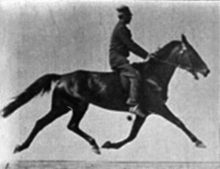Passage

Under amble or pass is meant a gait of four and Mehrbeinern which forms from the alternating movement of the respective right or left leg. For example, while the right hind leg and the right front leg are standing up at the same time or almost simultaneously and are carrying the weight, the opposite pair of left legs is in the air and swings forward. With some horse breeds, the pass is a special feature, with some mammals, however, the predominantly used mode of locomotion, for example with giraffes , camels , elephants or bears .
Passage with horses
The passport is undesirable as a gait in tournament sports in Germany . It leads to deductions in the evaluation in dressage tasks, in trotting to disqualification ("disqualification blue ").
With certain horse breeds (for example Icelanders or Paso Peruano ), the pass is part of the test (racing pass).
In some countries, such as the USA, trotting horses are specially trained and bred for the pass, as pure pass races are also run there. At present, higher speeds are achieved in pace races than in trot races, which is possibly due to the fact that the passer-by does not run the risk of kicking his foreleg with his hind foot and can therefore leave it longer on the ground to actively advance.
In the Middle Ages called were Zelter , the passport or gait walked, used as a travel horse.
Passage in humans
In humans, on the one hand, one speaks of a pass gait in the case of a rare disease with regard to motor skills , if the person concerned does not swing the opposite arm forwards - as is normal - to balance the balance, but, conversely, brings the right arm forward with the right foot.
On the other hand, in some schools of traditional Japanese martial arts ( Koryu ) and modern offshoots such as Aikido, such a gait is taught. There is lively speculation and discussion in the scene about the origin, purpose and distribution of the nanba aruki in ancient Japan and its status as a modern technology. In Shotokan karate and the Taekwon-Do based on it, a large part of the basic movements is also based on equal power transmission.
Passing is still a technique for climbing a ladder . The left arm and the left foot and then the right arm and the right foot are alternately put up a ladder rung.
Furthermore, in some dances it is the basic type of movement, such as B. in Slowfox .
In cross-country skiing , one speaks of pass gait when the leg kick and stick use of one side are performed at the same time and not - as is the case with the normal diagonal stride - in opposite directions.
